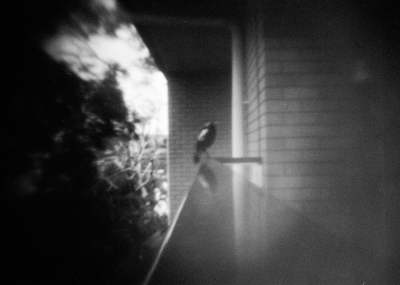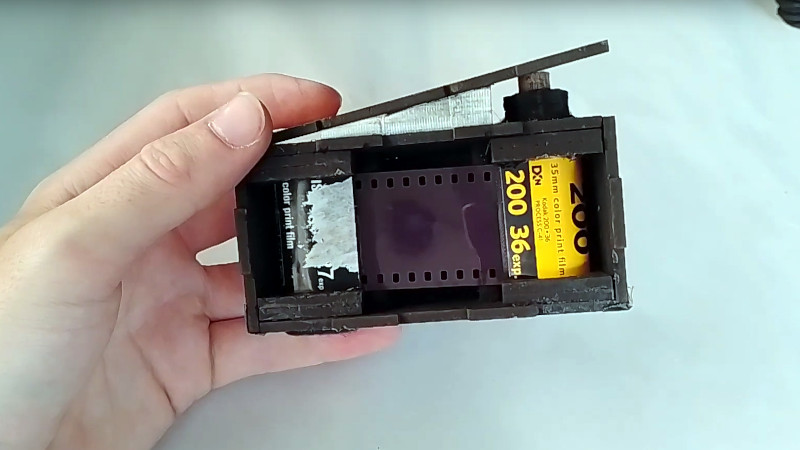Film cameras can be complex and exquisitely-crafted masterpieces of analogue technology. But at their very simplest they need be little more than a light-proof box with a piece of film at the back of it, and some kind of lens or pinhole with a shutter. [ChickenCrimpy] adds the most basic of 35 mm cartridge to create what he calls the Minimum Viable Camera. It’s a half-frame 35 mm pinhole film camera with the simplest possible construction.
 It can be built from almost any flat light-proof 3 mm thick stock, though something that you can run through a laser cutter is probably ideal. Once snapped together to make to box-like structure, tape is added along the joins for light-proofing. The film is reeled from a full 35 mm cartridge to an empty one, and cranked back frame-by-frame by means of a wooden key that engages with the spindle.
It can be built from almost any flat light-proof 3 mm thick stock, though something that you can run through a laser cutter is probably ideal. Once snapped together to make to box-like structure, tape is added along the joins for light-proofing. The film is reeled from a full 35 mm cartridge to an empty one, and cranked back frame-by-frame by means of a wooden key that engages with the spindle.
There’s no lens, instead this is a pinhole camera, and the shutter is a piece of the stock held on the front of the camera with bolts and butterfly nuts. Taking a photo is as simple as pointing the device at the subject and lifting the shutter away for a few seconds. There’s a video overview for the project which we’ve placed below the break.
It’s true that this camera needs a moment in the darkroom to load, but we like its extreme simplicity and the ethereal and grainy pictures it produces. If you fancy an introduction to 35 mm photography you could definitely do worse.
















My favorite course in college, Photography. I made a cassette tape and an altoids tin pinhole camera. Aka i used an exacto knife and lots of tape. Loading and unloading film constituted assembling and disassembling the entire thing in the pitch dark. Good times.
Exactly this… high school graphic arts class. Used a pringles tube, tinfoil (+prick from pin), tape, blacked out top, made small shutter with flap of paper, used photographic paper on the inside of the tube. Got the pic still somewhere… But I guess the point of this was for 35mm, but it did just say “MVC” and pinhole cam should count.
Well this was very pleasant to wake up to
I hope it’s enjoyed. Pinhole is a great start to photography
Estes Model Rockets “Camroc” was even more simple in construction! The shutter was operated by a rubber band that exposed a single B&W disc of film.
Check it out:
http://www.rcgrabbag.com/?p=305
This is great stuff. Love it! Want to see more of it.
I have a desire (but no time) to rebuild a fake twin-lens reflex I have to actually use both lenses properly. So that the viewfinder lens adjusts identically to the objective lens, making it practical to focus and fit a desired scene into the frame.
A pinhole camera was a classic project back in the day. Mine didn’t work very well when I was probably around 10 years old. But theoretically it is a simple project. Devil is always in the details. I think if I was willing to spend more time on trial on error I would have eventually worked it out, but I wasn’t that methodical as a child and didn’t have any adult to guide me.
The first camera I built was a coffee can with a pinhole in the side. The shutter was black vinyl tape over the hole. The first picture I took with it was of a girl laying down on grass in a park. It came out great; she later became my girlfriend :-)
I loved the article except the last sentence. “If you fancy an introduction to 35 mm photography you could definitely do worse.”
Ummm… HOW? With what could you do worse?
Oh yeah 100%
I cannot imagine a “worse” camera than this,in terms of actual image. It gets a pass on A E S T H E T I C , at most. It would be a fine thing to have as an educational tool in a photography class if you just wanted the absolute simplest camera out there that slotted into a 35mm development process
With care taken on the pinhole however it should be punching far above its weight in the realm of 35mm pinhole cameras
Has anyone tried making a pinhole camera out of an actual potato? That might be worse, especially if your film gets soggy with potato water.
This style pinhole cameras for 35mm have been made for ages. You can go even simpler with the same idea (reel-to-reel) by just using some cardboard over the film.
Pinhole photography is aweseome but this is in that scene like “look I made led blink with arduino”-style project.
Also keep in mind that 3D prints leak light easily and enough to fog the film (like I think I see in most of the photos in this project).
You aren’t wrong , it’s wildly basic but the interface with the 35mm cannister is nonetheless functional for repeated photo taking which is a step above simply making a pinhole camera from a shoe box
The appeal of this project to me was the robustness, and practical nature
Also, this one is laser cut, of which there are few designs available of this nature
The artifact you are observing is vignetting and just lack of detail on 35mm film not fogging, which is part and parcel of pinhole photography on 35mm
You are totally right though, this isn’t hugely complex. Just something I have been working on in my spare time at work and figured Hackaday might like , which I mean they have covered pinhole cameras before
“THE MINIMUM REQUIRED FOR A FILM CAMERA”
This is far beyond the minimum ;-)
A cookie tin and some scotch tape. That is nearer to the minimum.
Tape to mount the film in the tin. Drill a hole in the opposite wall and use another tape as a shutter.
(I once visited a whole exhibition of pictures taken with that kind of camera)
Of course there the tin was mounted on a manfrotto tripod. But I think that is optional.
Video has been around for a long time. Why would anybody go back to film?